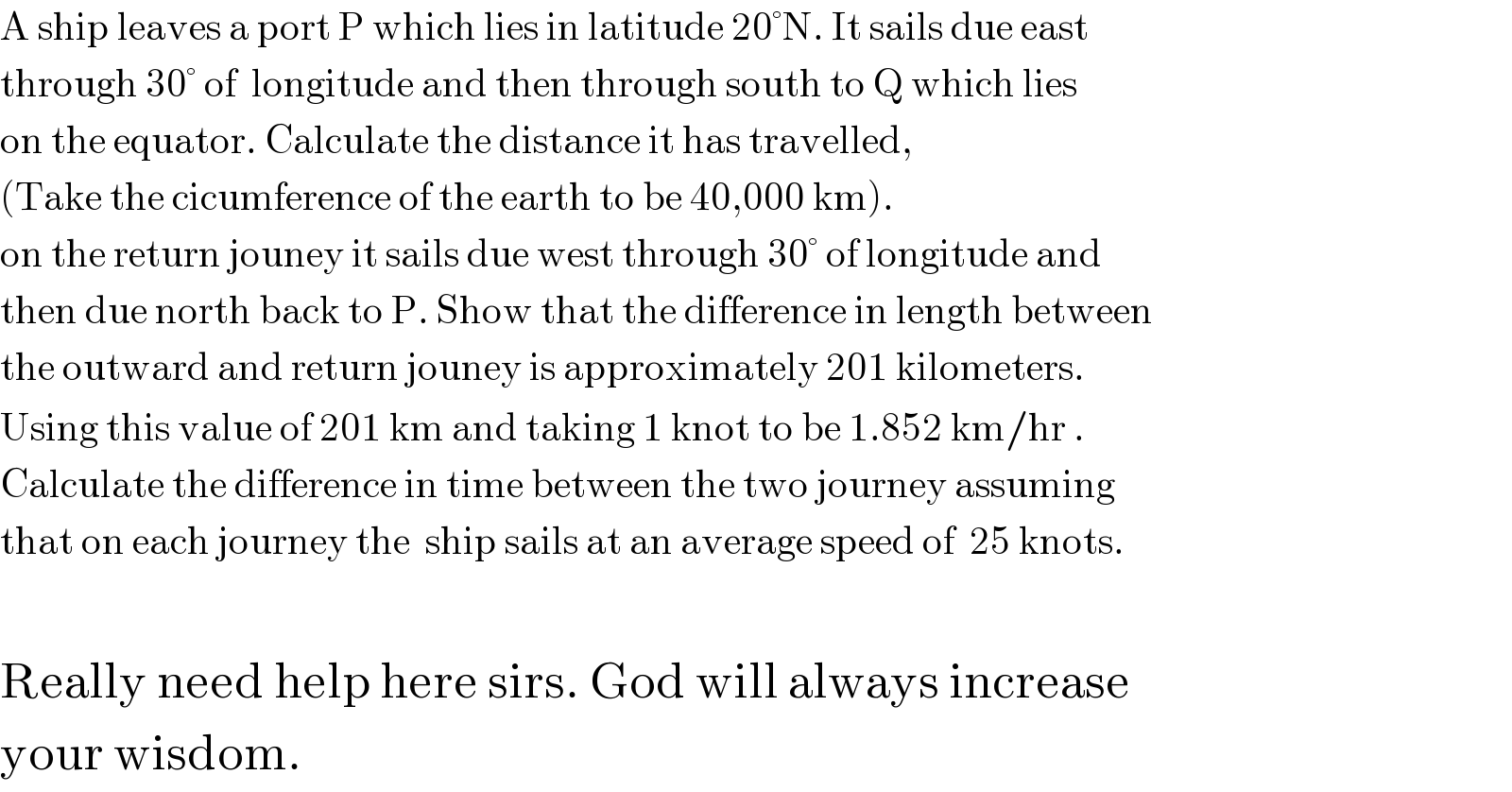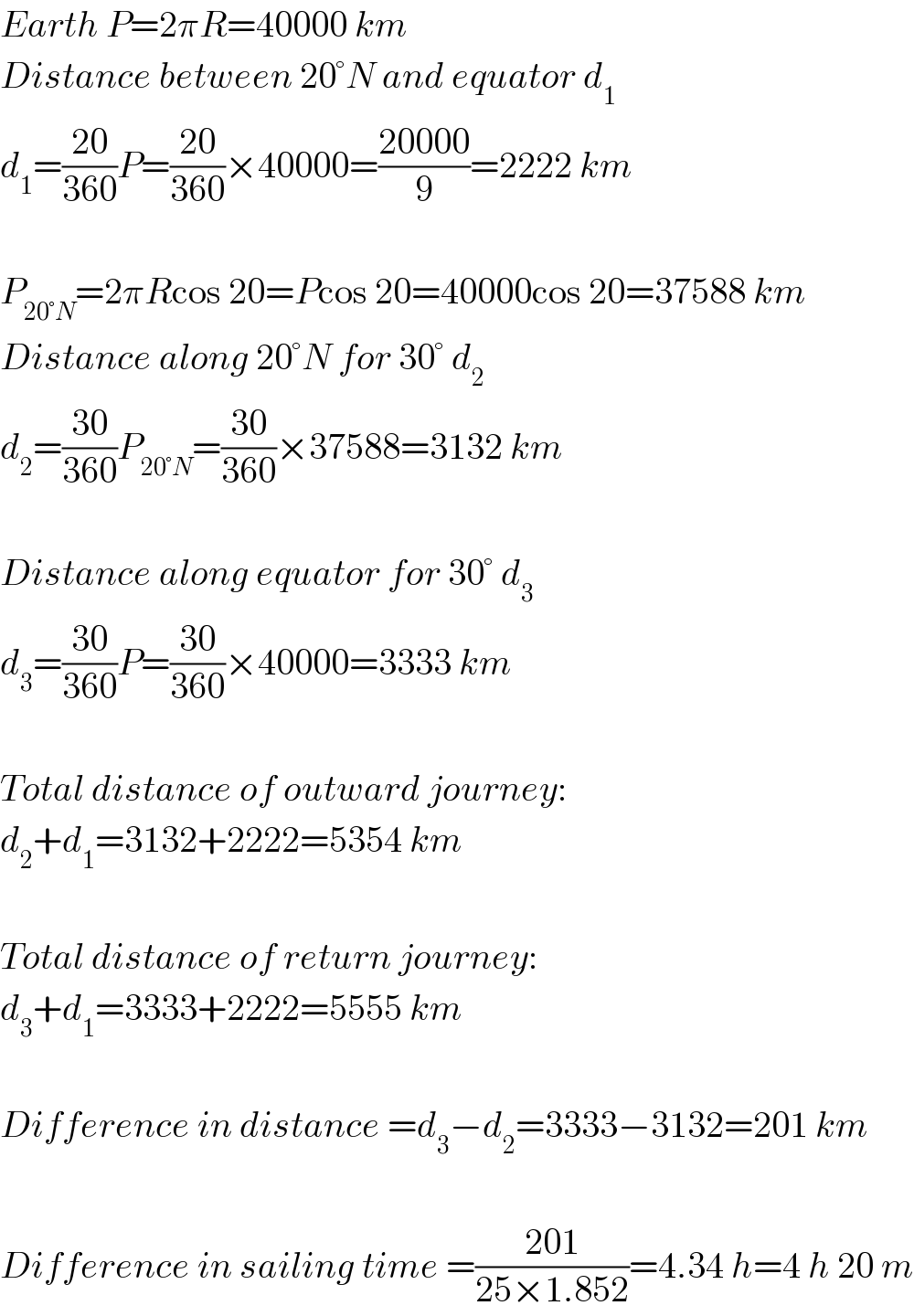Question Number 10653 by Saham last updated on 21/Feb/17

$$\mathrm{A}\:\mathrm{ship}\:\mathrm{leaves}\:\mathrm{a}\:\mathrm{port}\:\mathrm{P}\:\mathrm{which}\:\mathrm{lies}\:\mathrm{in}\:\mathrm{latitude}\:\mathrm{20}°\mathrm{N}.\:\mathrm{It}\:\mathrm{sails}\:\mathrm{due}\:\mathrm{east} \\ $$$$\mathrm{through}\:\mathrm{30}°\:\mathrm{of}\:\:\mathrm{longitude}\:\mathrm{and}\:\mathrm{then}\:\mathrm{through}\:\mathrm{south}\:\mathrm{to}\:\mathrm{Q}\:\mathrm{which}\:\mathrm{lies} \\ $$$$\mathrm{on}\:\mathrm{the}\:\mathrm{equator}.\:\mathrm{Calculate}\:\mathrm{the}\:\mathrm{distance}\:\mathrm{it}\:\mathrm{has}\:\mathrm{travelled}, \\ $$$$\left(\mathrm{Take}\:\mathrm{the}\:\mathrm{cicumference}\:\mathrm{of}\:\mathrm{the}\:\mathrm{earth}\:\mathrm{to}\:\mathrm{be}\:\mathrm{40},\mathrm{000}\:\mathrm{km}\right). \\ $$$$\mathrm{on}\:\mathrm{the}\:\mathrm{return}\:\mathrm{jouney}\:\mathrm{it}\:\mathrm{sails}\:\mathrm{due}\:\mathrm{west}\:\mathrm{through}\:\mathrm{30}°\:\mathrm{of}\:\mathrm{longitude}\:\mathrm{and} \\ $$$$\mathrm{then}\:\mathrm{due}\:\mathrm{north}\:\mathrm{back}\:\mathrm{to}\:\mathrm{P}.\:\mathrm{Show}\:\mathrm{that}\:\mathrm{the}\:\mathrm{difference}\:\mathrm{in}\:\mathrm{length}\:\mathrm{between} \\ $$$$\mathrm{the}\:\mathrm{outward}\:\mathrm{and}\:\mathrm{return}\:\mathrm{jouney}\:\mathrm{is}\:\mathrm{approximately}\:\mathrm{201}\:\mathrm{kilometers}. \\ $$$$\mathrm{Using}\:\mathrm{this}\:\mathrm{value}\:\mathrm{of}\:\mathrm{201}\:\mathrm{km}\:\mathrm{and}\:\mathrm{taking}\:\mathrm{1}\:\mathrm{knot}\:\mathrm{to}\:\mathrm{be}\:\mathrm{1}.\mathrm{852}\:\mathrm{km}/\mathrm{hr}\:. \\ $$$$\mathrm{Calculate}\:\mathrm{the}\:\mathrm{difference}\:\mathrm{in}\:\mathrm{time}\:\mathrm{between}\:\mathrm{the}\:\mathrm{two}\:\mathrm{journey}\:\mathrm{assuming} \\ $$$$\mathrm{that}\:\mathrm{on}\:\mathrm{each}\:\mathrm{journey}\:\mathrm{the}\:\:\mathrm{ship}\:\mathrm{sails}\:\mathrm{at}\:\mathrm{an}\:\mathrm{average}\:\mathrm{speed}\:\mathrm{of}\:\:\mathrm{25}\:\mathrm{knots}. \\ $$$$ \\ $$$$\mathrm{Really}\:\mathrm{need}\:\mathrm{help}\:\mathrm{here}\:\mathrm{sirs}.\:\mathrm{God}\:\mathrm{will}\:\mathrm{always}\:\mathrm{increase}\: \\ $$$$\mathrm{your}\:\mathrm{wisdom}. \\ $$
Answered by mrW1 last updated on 22/Feb/17

$${Earth}\:{P}=\mathrm{2}\pi{R}=\mathrm{40000}\:{km} \\ $$$${Distance}\:{between}\:\mathrm{20}°{N}\:{and}\:{equator}\:{d}_{\mathrm{1}} \\ $$$${d}_{\mathrm{1}} =\frac{\mathrm{20}}{\mathrm{360}}{P}=\frac{\mathrm{20}}{\mathrm{360}}×\mathrm{40000}=\frac{\mathrm{20000}}{\mathrm{9}}=\mathrm{2222}\:{km} \\ $$$$ \\ $$$${P}_{\mathrm{20}°{N}} =\mathrm{2}\pi{R}\mathrm{cos}\:\mathrm{20}={P}\mathrm{cos}\:\mathrm{20}=\mathrm{40000cos}\:\mathrm{20}=\mathrm{37588}\:{km} \\ $$$${Distance}\:{along}\:\mathrm{20}°{N}\:{for}\:\mathrm{30}°\:{d}_{\mathrm{2}} \\ $$$${d}_{\mathrm{2}} =\frac{\mathrm{30}}{\mathrm{360}}{P}_{\mathrm{20}°{N}} =\frac{\mathrm{30}}{\mathrm{360}}×\mathrm{37588}=\mathrm{3132}\:{km} \\ $$$$ \\ $$$${Distance}\:{along}\:{equator}\:{for}\:\mathrm{30}°\:{d}_{\mathrm{3}} \\ $$$${d}_{\mathrm{3}} =\frac{\mathrm{30}}{\mathrm{360}}{P}=\frac{\mathrm{30}}{\mathrm{360}}×\mathrm{40000}=\mathrm{3333}\:{km} \\ $$$$ \\ $$$${Total}\:{distance}\:{of}\:{outward}\:{journey}: \\ $$$${d}_{\mathrm{2}} +{d}_{\mathrm{1}} =\mathrm{3132}+\mathrm{2222}=\mathrm{5354}\:{km} \\ $$$$ \\ $$$${Total}\:{distance}\:{of}\:{return}\:{journey}: \\ $$$${d}_{\mathrm{3}} +{d}_{\mathrm{1}} =\mathrm{3333}+\mathrm{2222}=\mathrm{5555}\:{km} \\ $$$$ \\ $$$${Difference}\:{in}\:{distance}\:={d}_{\mathrm{3}} −{d}_{\mathrm{2}} =\mathrm{3333}−\mathrm{3132}=\mathrm{201}\:{km} \\ $$$$ \\ $$$${Difference}\:{in}\:{sailing}\:{time}\:=\frac{\mathrm{201}}{\mathrm{25}×\mathrm{1}.\mathrm{852}}=\mathrm{4}.\mathrm{34}\:{h}=\mathrm{4}\:{h}\:\mathrm{20}\:{m} \\ $$
Commented by Saham last updated on 22/Feb/17

$$\mathrm{Wow}..\:\mathrm{Great}..\:\mathrm{i}\:\mathrm{have}\:\mathrm{tried}\:\mathrm{it}\:\mathrm{but}\:\mathrm{i}\:\mathrm{did}\:\mathrm{not}\:\mathrm{get}\:\mathrm{it}. \\ $$$$\mathrm{Now}\:\mathrm{i}\:\mathrm{understand}.\:\mathrm{God}\:\mathrm{bless}\:\mathrm{you}\:\mathrm{sir}. \\ $$
